M.LiT, Museum Leaders in Training is VMFA’s leadership program for teens, grades 8 – 12. Through hands-on workshops, insightful lectures, and engaging discussion, participants learn from visiting artists, college students, VMFA staff, and museum professionals. M.LiT students explore museum and art-related careers while serving as both advisers and participants in the development of teen programs.
This audio guide was developed from the work of M.LiT participants, who learn to write their own gallery tours and serve as junior tour guides during large teen events. VMFA staff selected one object from each tour, and M.LiT participants narrowed the works down further, identifying a single cohesive theme: Depictions of Divinity.
The thirteen works presented here explore that theme. While viewing the work and listening, visitors will be intrigued by seemingly arbitrary objects, enticed by musical compositions, receive insightful information, hear six-word memoirs, and make connections to other works in the VMFA’s collections.
As the project developed, M.LiTers came to the conclusion that there was no single path to understanding the depiction of divinity in works of art.
Download the guides below… choose your path and, at the conclusion follow the instructions to share how you were enlightened.
Download the Teen Audio Guide: Depictions of Divinity
Find out more about Museum Leaders in Training (M.LiT).
Audio Tour
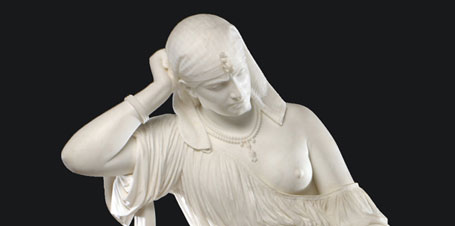
Cleopatra, 1858
William Wetmore Story (American, born 1819)
White marble
J. Harwood and Louise B. Cochrane Fund for American Art
Written and recorded by Lanecha Lewis, Jake McKnight, and Kelsey McGregor
Play MP3:
The throne represents great power. Cleopatra proclaimed her own divinity as the reincarnation of the goddess Isis, who is represented by the throne. Cleopatra was born in 69 BC in Alexandria, Egypt. She reigned as a pharaoh of Egypt from 51-30 BC. Cleopatra’s name in Greek and means “Glory of her Father”. Cleopatra was a descendent of one of Alexander the Great’s generals. She has also been romanticized in modern times as the lover of Julius Caesar and Mark Antony. Cleopatra was very intelligent and she could speak seven languages. Her knowledge allowed her to manipulate others. In Ancient Egypt, those in power were viewed as gods and goddesses. In 30 BC Cleopatra was captured by Octavian the ruler of Rome. It is thought that in a final act of power Cleopatra takes her own life using the venom of an asp. Perhaps here she sits contemplating this bold act.
Now we would like to leave you with this short conclusion: Self proclaimed divinity, embodiment of Isis.
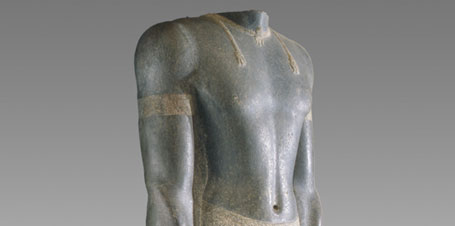
Statue of Senkamanisken, King of Kush, 7th century B.C.
Egyptian
Gray-black granite
Adolph D. and Wilkins C. Williams Fund
Written and recorded by Hiba Seager, Cassandra Martinez, and Irene Koo
Play MP3:
The kilt you see above was a traditional symbol of Scottish culture. Throughout the world, articles of clothing such as this one have signified something within each society. Just as this kilt may be traced to Scotland, the garment worn by this statue of the King of Kush would have frequently been worn by royalty. In his garb and with his large size, this statue of the King of Kush exudes power and importance, commemorating a royal figure of Kush and honoring him as living god on Earth. Artists of the time would have been commissioned to commemorate him for his power and importance. The statue is also connected to the sentiment that the King of Kush was an immortal being. The King of Kush was worshipped by the people alongside other Egyptian gods.
And now we would like to leave you with this short conclusion: Rule over mortals, immortal for eternity.
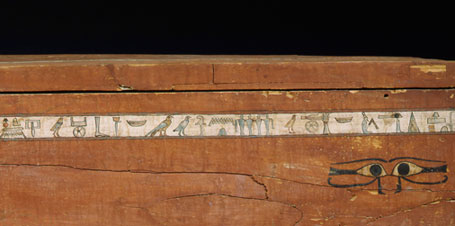
Coffin of Tjeby, 3rd millennium B.C.
Egyptian
Wood, painted; linen wrapped mummy
Adolph D. and Wilkins C. Williams Fund
Written and recorded by Morgan Lewis, Kaity O’Reilly, and Sayantanee Das
Play MP3:
We chose eyes as our visual hook because the eyes painted on the coffin symbolize the mummy inside looking through the eyes of Horus, the divine deity of protection. This was to ensure a safe journey to the Afterlife as he looks towards the setting sun. The Ancient Egyptians had complex beliefs about the Afterlife. They believed that the Afterlife was their utopia where they would be able to continue a better version of their life. This specific coffin is from the Intermediate period. Coffin’s were not as detailed during this period as in later periods when design became more elaborate as one could afford. This simple, rectangular coffin is made wood with hieroglyphs, or symbols that represent ideas and sounds, depicted all around the coffin and on the lid. The Hieroglyphs are different from hieroglyphics in that they are characters of the Egyptian alphabet. The Hieroglyphs on this coffin are a prayer that was designed specifically to send the mummified person safely to the Afterlife. This Egyptian was named Tjeby and he was a Court and Seal bearer to the King of Lower Egypt. He was mummified in order to provide the King with continued service in the Afterlife because mummification was not common at this time as a result of the expense.
We summarized our interpretation of this piece in six words, known as a six-word memoir: Seeing past life, leads to paradise.
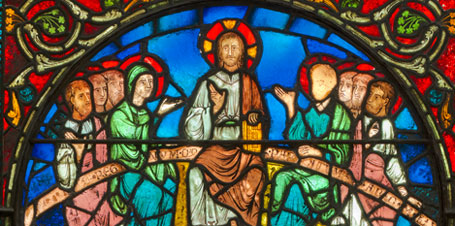
“St. Stephen Disputing with Jews” & “Last Judgment”, 12th-13th century
English
Stained glass with leading
Adolph D. and Wilkins C. Williams Fund
Written and recorded by Lillian Herrell, Lindsay Hawk, and Reed Canaan
Play MP3:
Resurrection is a reoccurring theme in Christianity. Much like a phoenix, these windows have a similar story of transformation. Leaded glass windows, commonly known as stained glass windows, are found in churches around the world. These two circular roundels would have originally appeared in the Canterbury Cathedral in England as separate windows. During the Counter Reformation, art was meant to be used as a teaching mechanism because the largely illiterate population attending a service needed a visual representation of bible stories and Christ. The visual depictions of divinity helped Christians better understand their faith. The upper roundel depicts the Last Judgment, while St. Stephen Disputing with the Jews appears in the lower one. At some point, these roundels, along with the upper and lower floral boarders, were removed from their original positions and stored in the Cathedral. They were then sold and placed together for the first time. The newer glass was added around the roundels to create a cohesive piece. Like the Christian belief in Jesus’ resurrection, this window was resurrected into something greater than its original parts.
We would like to leave you with this six-word memoir summarizing the life of the roundels: For sale: window, no assembly required.
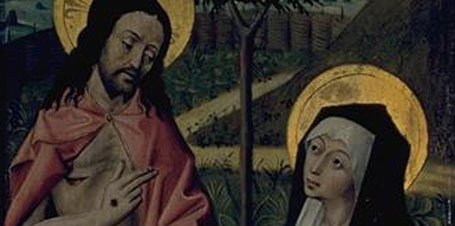
Christ Appearing before Mary Magdalene, 15th century
Follower of Nicolas Froment
Tempera on panel
Adolph D. and Wilkins C. Williams Collection
Written and recorded by Nikita Cotzias, Naomi Bloom, and Tanvi Kohli
Play MP3:
The renewal of leaves in the spring is often associated with the resurrection of Christ, a miracle that took place in the spring. Jesus is holding a spade in the painting, which is a reference to the passage in the gospel of John where Mary mistakes Jesus for a gardener rather than realizing the man she has encountered is Jesus resurrected. The artist of Christ Appearing Before Mary Magdalene was a follower of Nicolas Froument whose painting reflected the new interest in naturalism that characterized the flowering of the Renaissance. This explains the artist’s effort to make the painting realistic. However, Jesus is painted in hieratic scale, meaning that he is proportionally larger than the other elements in the painting. His hands and feet are also larger in proportion to his body. This exaggeration is most likely used to emphasize the wounds of the crucifixion, because those wounds are the proof to Mary that this man is indeed Jesus resurrected.
Now, to remember this piece, please enjoy this six-word memoir: Christ is resurrected: proving his divinity.
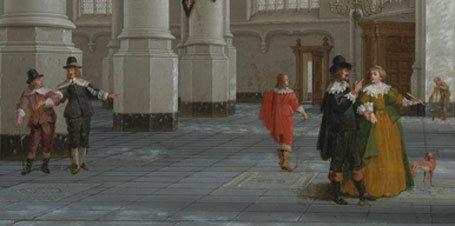
Interior of the Church of St. Laurens, Rotterdam, 17th century
Anthonie DeLorme, (Dutch, born 1610)
Oil on panel
Arthur and Margaret Glasgow Fund
Written and recorded by Grace Redding, Tyler Ludlam, and Kelsey Cunningham
Play MP3:
During the Protastant Reformation walls in Protestant churches were often painted white. In many religious contexts, the color white represents both purity and simplicity. The Protestant Reformation attempted to cleanse and renew the Roman Catholic Church acoss Europe. The Interior of the Church of St. Laurens in Rotterdam, by Anthonie de Lorme, depicts a building devoted to the new approach of worship practiced by many Protestant groups. Instead of associating the Christian faith with exquisitie works of art created to reflect the glory of God Protestants turned directly to the scriptures, rejecting the intricate altar paintings, stained glass windows, statues, icons, and opulence of the Roman Catholic church. The once ornate interior has been whitewashed over, purifying the church in accordance with these new beliefs. Additionally, the stained glass windows, were removed and replaced with plain, translucent, grisaille windows. The only color remaining was found on the biblical shields, emphasizing the importance of scriptures. The Interior of the Church of St. Laurens suggests that the new Protestants had begun to approach God and to receive guidance individually, rather than through the mediation of Protestant ministers.
And now, we would like to leave you with this short conclusion: Whitewashed with renewal; guiding, changing ideas.
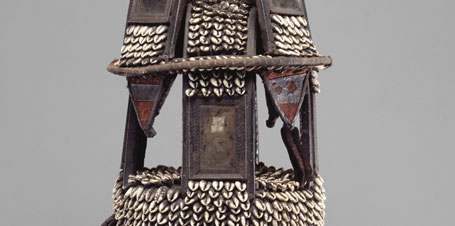
House of the Head, 19th-20th century
African
Cowry shells, leather, wood, mirrors, metal, string, cloth, and natural fibers
Art Purchase Fund
Written and recorded by Ben Wong and Kristina Dickey
Play MP3:
Ideas, emotions, and personal preferences all originate in one place: the brain. Thoughts and feelings define one as an individual, and many choose to express their individuality through their appearance. But this isn’t a 21st century concept. People of the Yoruba, a culture in modern day Nigeria, also associated the brain as the center of communication and personality, and the head as a vehicle to outwardly express one’s identity. The importance of the head is seen in these sculptures called Ibori, or “Head Container,” and Ile ori, or “House of the Head.” Every Yoruba adult traditionally owned a shrine such as this one. The Ile ori represented one’s outer personality and was used to shape one’s identity. Adults conveyed a higher social status by elaborately decorating their Ile ori with cowry shells, mirrors, and leather. The Ile ori was used to cover the Ibori. People made sacrifices to the Ibori, the place of the Yoruba deity, Olodumare. By worshipping Olodumare, they learned to apply patience and control in their everyday lives. The Yoruba people depicted divinity through the Ile ori to objectify abstract religious ideas as well as to make a physical connection to Olodumare, someone they deeply appreciated.
The significance of the Ile ori and Ibori is huge, but can be represented by these six words: My head, the center of life.

Meritatio, 1978
Brice Marden, (American, born 1938)
Oil paint and wax on canvas
Gift of the Sydney and Frances Lewis Foundation
Written and recorded by Sophie Eichner, Chloe Houdek, and Camille Karabaich
Play MP3:
The mood ring supposedly measures emotion which is gauged by the color of the ring and Meritatio is also using color to gauge and express Mary’s emotions. Brice Marden‘s Meritatio has been called “one of the most moving works of 20th century religious art”. Now you are probably thinking how does this simple piece have anything to do with religion? Meritatio is the last of a five part series- the “Annunciation”- where he interprets in his own way the five emotional stages the Virgin Mary went through after the Annunciation. For those who are not familiar with what the annunciation is, it was when the Angel Gabriel came to tell Mary that she was to give birth to Jesus, at the ripe old age of seventeen. These stages that Marden depicts in the series are Disquiet, Reflection, Inquiry, Submission, and Merit. Merit- or Meritatio– being the one we are looking at today. Now, how would you feel? Teenage girl – around 17 years old- just told she is going to bear a child, having done nothing wrong; a child destined to not only change the world but suffer for all of man’s sins. Now I don’t know about you, but I find that that a lot to handle. The artist is quoted as saying “Painters are amongst the priests – worker priests of the cult of man – searching to understand but never know.” Now what do you think Marden meant by this? What is the role of the artist in culture, religion, and society? Each individual piece in the series unfolds like a drama, creating an emotional story through color. A story that the artist hopes, will allow you the viewer to feel the emotions of a very human Mary. Meritatio consists of four separate panels, each with a different color applied with a mixture of oil and wax. Marden didn’t like the shiny reflective qualities of oil, thus by adding a wax medium he could achieve a duller, matte -meaning non-shiny- surface. So that you, the viewer, can focus and meditate upon the colors.
Our six-word memoir is: Seventeen: Gabriel gives me holy baby.
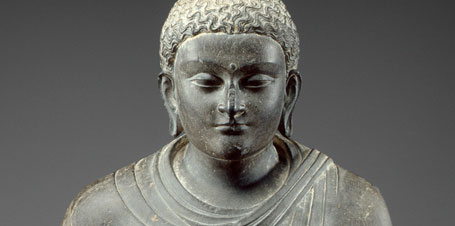
Seated Buddha, 2nd–3rd century
Indian
Dark gray schist
Adolph D. and Wilkins C. Williams Fund
Written and recorded by Connor Crable, Elizabeth Ezzelle, and Francine Jackson
Play MP3:
You can see from the piece that the Buddha has long, droopy ear lobes similar to what one would see today with gauged earrings. The Buddha was once a prince named Siddartha Gautuma. He deserted his life of privilege to pursue righteousness. When he deserted his life, he also removed the heavy, royal earring he wore. For that reason, his earlobes are a symbol of his sacrifice. This visual image of Buddha would have been in a temple. Originally, the religion did not recognize Buddha as a godly and divine figure, but as other religions had these worshipped figures, Buddha became a deity of the religion. The cranial lump, and the curl of hair in between the eyes both show the wisdom of Buddha. These are also traits that are very distinctive of Buddha. The broken hand would have been in the shape of a Mudra. This is a symbol stating that Buddha has great power, yet one should not fear him.
And now we leave you with a six-word memoir: Posthumously made God, now represent me.
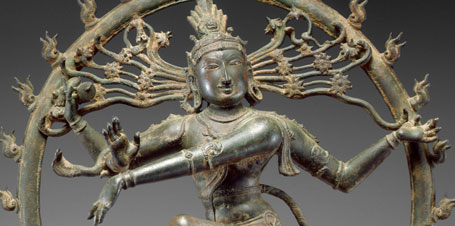
Shiva as King of Dancers, 12th century
Indian
Copper alloy
Adolph D. and Wilkins C. Williams Fund
Written and recorded by Sequioa Roscoe and Maggie O’Connor
Play MP3:
With the male and female symbols, Shiva acts as both signifying the ability for everyone to relate and believe in her. All are able to worship her. Each culture retains their own individual variance regarding omnipotence and their belief systems. In Hindu culture, Shiva acts as an ultimate being, his role as both a creator and a destroyer. Symbolizing destruction, Shiva dances in the ring of fire in the face of creating the world evoking the Hindu concept of reincarnate time. To accompany his dance the finger symbols in his right hand are used because in Hindu creationism they believe the world was started with sound. Shiva stands upon the demon of ignorance and forgetfulness reminding his followers to remain good and faithful in order to reach the ultimate state of enlightenment personified by his third eye.
And now we will leave you with this six-word memoir: Shiva is considered the greatest god. Worship of Shiva has existed since the early 1100’s. Believers still worship him more than ever because they believe that they gain strength and enlightenment.
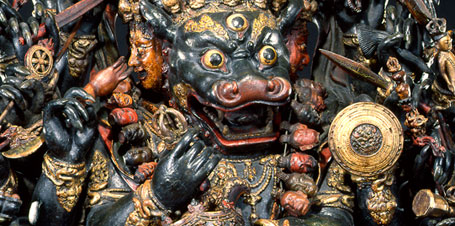
Yamantaka, 18th century
Sino-Tibetan
Polychromed wood
Arthur and Margaret Glasgow Fund
Written and recorded by Morgan Mitchell, Emily Watlington, and Brannon Dorsey
Play MP3:
Depicted in the thumbnail image for this work is a Himalayan Mountain Dog, a large dog often used for protection and known to have a lovely bedside manner. Aside from the physical resemblance between this animal and the piece before you, both are considered ferocious guardians and protectors of the sacred realm. Yamantaka acts as a guiding figure down the path to enlightenment by combating forces of evil. Tibetan Buddhists are taught to follow the “path of enlightenment” and the Yamantaka is a key part to this journey, therefore it was also one of the favored deities. Buddhists find comfort in Yamantaka’s power over evil. One of the ways the artist depicted this power was by emphasizing the size of the garlands of heads in relation to the size of the Yamantaka. Additionally, the deity has multiple heads and limbs, making him a formidable opponent. The viewer quickly recognizes Yamantaka’s wrathful vengeance and powerful dominion over any unwanted, ill-willed beings.
The music you are listening to is that of traditional Tibetan song. As this audio guide concludes, please enjoy a six-word memoir summarizing the impact of this piece. People will become safe past me.
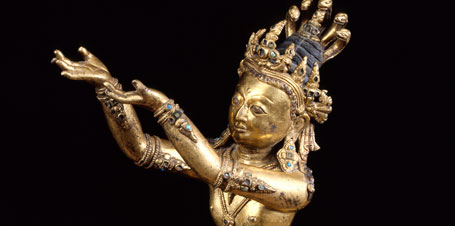 <
<
Serpent King (Nagaraja), 15th–16th century
Tibetan
Gilded copper alloy and gemstones
Gift of the E. Rhodes and Leona B. Carpenter Foundation, from the Berthe and John Ford Collection
Written and recorded by Jenny Kacani, Jessica Zheng, and Brittany Ingarra
Play MP3:
The Serpent King, or Nagaraja, both worshiped and offered protection to the Buddha. A comparison can be made between Nagaraja and an umbrella as Nagarja offers shelter to the Buddha from outside forces. In one story the Buddha sat under the Muchilinda tree for seven days, enjoying the bliss of meditation. A great cloud appeared, and for seven days, there were cold winds and rain. The Nagaraja arose from his abode, in the form of a giant snake, and wrapped himself around the Buddha seven times, sheltering the Buddha’s head with his hood, protecting the Buddha from the harsh weather, not unlike an umbrella. At the end of the seven days the weather cleared, and the Nagaraja, changing his form to a young man, did reverence to the Buddha.
This piece of art depicts the Serpent King in a pose of adoration towards the Buddha. His arms are extended forward and his pose indicates flight. While the Serpent King is not divine, he represents the adoration of divinity. This is an example of the Iconography of Buddhism and the Worship of the Buddha. As you can see, the Serpent King’s dynamic energy emanates from the figure’s golden luster, elaborate cobra hood, and turquoise stones. These features attract the eye as well as showcase his importance.
We will leave you with this six word memoir: In a leap of complete adoration
Conclusion
Now that you have explored the M.LiT Audio Tour, in only six words, share why you think artwork depicts divinity or share response to one of the works on the tour, Tweet @VMFA Education #M.LiT “type your six-word memoir here.”